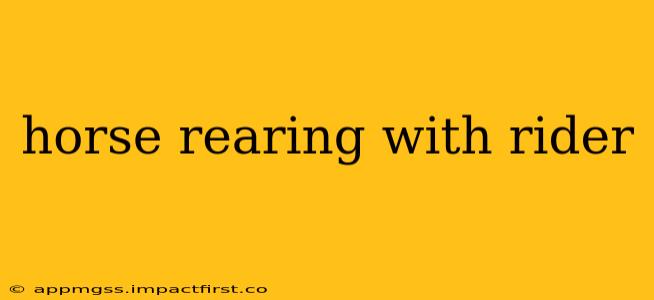Horse rearing, where a horse rises up on its hind legs, can be a breathtaking sight, but it's also a potentially dangerous behavior, especially with a rider. Understanding the causes, recognizing the signs, and knowing how to react are crucial for both rider and horse safety. This comprehensive guide explores the intricacies of horse rearing, providing insights into prevention, management, and emergency response.
Why Does a Horse Rear?
Horses rear for a variety of reasons, ranging from fear and pain to learned behavior and excitement. Understanding the underlying cause is the first step towards addressing the problem. Some common reasons include:
- Fear or Anxiety: A sudden loud noise, unexpected movement, or a perceived threat can trigger a rearing response as the horse attempts to escape.
- Pain: Discomfort in the mouth, back, or legs can cause a horse to rear as a way of expressing pain or attempting to relieve pressure. Dental issues, saddle sores, and lameness are common culprits.
- Learned Behavior: If a horse has successfully used rearing to escape a situation in the past (e.g., avoiding work or a disliked task), it's more likely to repeat the behavior. This is why consistent and clear communication is vital.
- Excitement or High Energy: Young horses, or those with a lot of pent-up energy, may rear out of exuberance, especially when anticipating a ride or other activity.
- Rider Imbalance or Poor Communication: Unbalanced riding, inconsistent aids, or harsh handling can inadvertently encourage rearing.
What are the Signs a Horse Might Rear?
Recognizing early warning signs is critical. These subtle cues can help riders anticipate a potential rear and take preventive measures:
- Stiffening of the body: The horse may tense its muscles, particularly in the neck and back.
- Head tossing: The horse may repeatedly toss its head, showing signs of discomfort or agitation.
- Increased sensitivity to the bit: The horse may become overly reactive to the bit, pulling or resisting the rider's aids.
- Changes in behavior: The horse may show increased nervousness, becoming more easily startled or agitated than usual.
How Can I Prevent My Horse from Rearing?
Prevention is key. Consistent, positive training and a strong rider-horse relationship can significantly reduce the risk of rearing.
- Professional Training: Working with a qualified and experienced horse trainer is essential, especially if your horse has a history of rearing.
- Consistent Riding: Regular, consistent training sessions help build a strong foundation and improve communication between rider and horse.
- Proper Saddle Fit: Ensure that the saddle fits correctly to prevent discomfort and pain.
- Gentle Handling: Avoid harsh or abrupt movements or commands that could startle the horse.
- Desensitization: Gradually expose your horse to various stimuli (e.g., loud noises, sudden movements) in a controlled manner to help it become less reactive.
What Should I Do if My Horse Starts to Rear?
If your horse begins to rear, your immediate reaction is crucial. Safety is paramount:
- Maintain a loose rein: Holding onto the reins tightly can increase the risk of injury to both rider and horse.
- Lean forward: Leaning forward helps shift your center of gravity, maintaining balance.
- Release the pressure on the reins: Releasing the reins allows the horse more freedom to find its balance.
- Avoid using spurs or crops: These can exacerbate the situation, causing further fear and agitation.
- Try to guide the horse back down: If possible, gently guide the horse back to the ground using your legs and seat.
Is Rearing Always Dangerous?
While rearing can be dangerous, not every instance is a major emergency. The severity depends on the horse's temperament, the height of the rear, and the rider's ability to maintain balance and control. However, it's vital to address rearing behavior promptly to prevent it from escalating into a habit.
How Can I Help My Horse Recover from a Rearing Incident?
After a rearing incident, prioritize the horse's well-being:
- Assess for injuries: Check both the horse and yourself for any injuries.
- Provide reassurance: Offer your horse comfort and reassurance, showing that you are not angry or punishing.
- Consult a veterinarian: If there are any signs of injury, consult a veterinarian immediately.
- Seek professional guidance: Seek the help of a qualified equine professional to address the underlying cause of the rearing and develop a plan for future prevention.
Can a Rearing Horse Be Re-trained?
Yes, many horses that rear can be successfully retrained with patient, consistent, and professional guidance. This process often requires a combination of desensitization, positive reinforcement, and addressing any underlying physical or psychological issues. Remember that safety is always the top priority.
This article provides general information about horse rearing. For specific advice tailored to your horse and your circumstances, always consult a qualified and experienced equine professional. Never hesitate to seek professional help if you encounter challenges in managing your horse's behavior.
